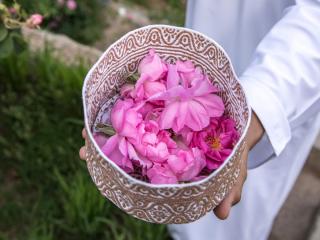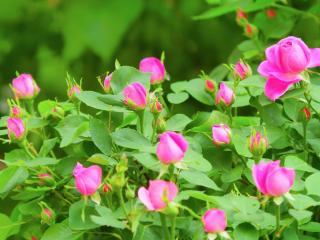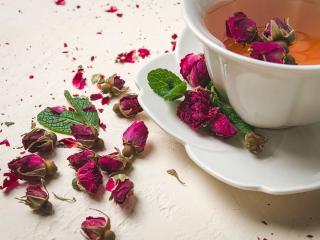

The Damask rose, an ancient rosebush from Syria, underwent a lot of hybridization throughout the 19th century.
Famous since ancient times for its captivating scent, Rosa × damascena has become a top choice in perfume and cosmetic industries. In private gardens, however, they’ve often been superseded by modern repeat-flowering roses: we now see fewer Damascus roses in stores for sale. Their petals remain the key ingredient when crafting rose essence and rose water, especially in Morocco.
Latin name: Rosa ×damascena
Common name: Damascus rose
Family: Rosaceae
Origin: Syria
Height: 3 ⅓ to 6 ½ feet (de 1 à 2 m)
Form: upright
Bloom: June to November
Repeat-flowering rose: depends on sub-variety
Flower color: pink or white
Planting: January to April and September to December
Exposure: sunny
Cold hardiness: 5°F (-15°C)
Soil: all types, fertile, moist, and deep
Use: decoration, perfume, cosmetic, cooking

Depending on the variety, Damascus roses display a beautiful spectrum of pink shades, sometimes venturing into white.
→ Blooming fact: Only Rosa × damascena ‘Four seasons’ boasts repeat blooms throughout the prime season. Other varieties only have a single wave of flowers.
Cultivating these roses is very easy thanks to their extreme resistance. They can all endure deep freezing, down to to even to 5°F (-15°C). Just make sure you give them a sunny spot to maximize flowering.
 Rosa x damascena ‘Four Seasons’
Rosa x damascena ‘Four Seasons’This ‘Four Seasons’ Damascus rose shows off semi-double flowers with a lively scent, about 2¾ inches across (7 cm) and pinkish in hue. They bloom from June all the way to November! But their petals aren’t very durable, sometimes lasting only a day or two.
From June to July, the rose of Kazanlik generously gifts semi-double flowers, around 2¾ inches wide (7 cm), flaunting light pink petals with a golden heart. Their lasting sweet scent paved the way to becoming the most-grown flower for Bulgaria’s essence and floral water production. This rose is particularly resistant to heat?
‘Rose de Rescht’ offers a plethora of fruity-scented flowers until November. With a diameter of about 2⅜ inches (6 cm), these fully double blooms range in color between red and magenta. Cold and disease? It brushes them off like a champ.
‘Mme Hardy’ unfurls her intensely scented, pure white double flowers, with a hint of green at the core. With a size of around 2¾ inches across (7 cm), it loves deep, cool soil.
From June to July, ‘Marie Louise’ showcases large double flowers roughly 3½ inches in size (9 cm). Curled petals of a rich pink hue, arching stems with few thorns, and leafage that is highly resistant to disease are the hallmarks of this rather short variety.
Damask rose essential oil stands out as a traditional favorite for its regenerating action. Organic cosmetic enthusiasts appreciate it and include it in serums and age-defying moisturizers to counter dryness and aging skin. This oil indeed works marvels for skin tone.
Note, however, that it is a relatively rare – and expensive – essence. Making it involved collecting tons of petals, which must be carefully handled and immediately processed to shield them from oxidation. Producing Damask rose essential oil is an art unto itself, a ballet of sorts from field to flask, much more difficult than lavender oil to prepare, for instance.
Important note: Using essential oils isn’t benign. Damask rose oil is no exception. It suits all skin types without any side effects, but only when properly dosed.

But aside from their fame in the world of perfume, both the ‘Four Seasons’ Damask rose and the ‘Rose of Rescht’ dabble in culinary endeavors, too. They are dreamily delicious in jams, pastries, and even drinks such as syrup and tea.